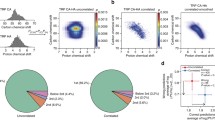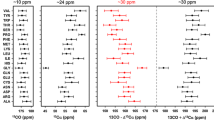Abstract
Carbonyl 13C′ relaxation is dominated by the contribution from the 13C′ chemical shift anisotropy (CSA). The relaxation rates provide useful and non-redundant structural information in addition to dynamic parameters. It is straightforward to acquire, and offers complimentary structural information to the 15N relaxation data. Furthermore, the non-axial nature of the 13C′ CSA tensor results in a T1/T2 value that depends on an additional angular variable even when the diffusion tensor of the protein molecule is axially symmetric. This dependence on an extra degree of freedom provides new geometrical information that is not available from the NH dipolar relaxation. A protocol that incorporates such structural restraints into NMR structure calculation was developed within the program Xplor-NIH. Its application was illustrated with the yeast Fis1 NMR structure. Refinement against the 13C′ T1/T2 improved the overall quality of the structure, as evaluated by cross-validation against the residual dipolar coupling as well as the 15N relaxation data. In addition, possible variations of the CSA tensor were addressed.





Similar content being viewed by others
References
Allard P, Härd T (1997) NMR relaxation mechanisms for backbone carbonyl carbons in a 13C, 15N-labeled protein. J Magn Reson 126:48–57
Barbato G, Ikura M, Kay LE, Pastor RW, Bax A (1992) Backbone dynamics of Calmodulin studied by 15N relaxation using inverse detected 2-dimensional NMR spectroscopy – The central helix is flexible. Biochemistry 31:5269–5278
Bertini V, Janik MBL, Lee Y-M, Luchinat C, Rosato R (2001) Magnetic susceptibility tensor anisotropies for a lanthanide ion series in a fixed protein matrix. J Am Chem Soc 123:4181–4188
Bertini I, Bianco CD, Gelis I, Katsaros N, Luchinat C, Parigi G, Peana M, Provenzani A, Zoroddu MA (2004) Experimentally exploring the conformational space sampled by domain reorientation in calmodulin. Proc Natl Acad Sci 101:6841–6846
Biekofsky RR, Muskett FW, Schmidt JM, Martin SR, Browne JP, Bayley PM, Feeney J (1999) NMR approaches for monitoring domain orientations in calcium-binding proteins in solution using partial replacement of Ca2+ by Tb3+. FEBS Lett 460:519–526
Bruschweiler R, Liao X, Wright PE (1995) Long-range motional restrictions in a multidomain zinc-finger protein from anisotropic tumbling. Science 268:886–889
Chang S-L, Tjandra N (2005) Temperature dependence of protein backbone motion from carbonyl 13C and amide 15N NMR relaxation. J Magn Reson 174:45–53
Clore GM, Gronenborn AM, Szabo A, Tjandra N (1998) Determining the magnitude of the fully asymmetric diffusion tensor from heteronuclear relaxation data in the absence of structural information. J Am Chem Soc 120:4889–4890
Cornilescu G, Marquardt JL, Ottiger M, Bax A (1998) Validation of protein structure from anisotropic carbonyl chemical shifts in a dilute liquid crystalline phase. J Am Chem Soc 120:6836–6837
Cornilescu G, Bax A (2000) Measurement of proton, nitrogen, and carbonyl chemical shielding anisotropies in a protein dissolved in a dilute liquid crystalline phase. J Am Chem Soc 122:10143–10154
Dayie KT, Wagner G (1995) Carbonyl-carbon relaxation rates reveal a dynamic heterogeneity of the polypeptide backbone in villin 14T. J Magn Reson Series B 109:105–108
Dayie KT, Wagner G (1997) Carbonyl carbon probe of local mobility in 13C, 15N-enriched proteins using high-resolution nuclear magnetic resonance. J Am Chem Soc 119:7797–7806
de Alba E, Tjandra N (2000) Protein backbone 15N relaxation rates as a tool for the diagnosis of structure quality. J Magn Reson 144:367–371
Delaglio F, Grzesiek S, Vuister GW, Zhu G, Pfeifer J, Bax A (1995) NMRPipe: a multidimensional spectral processing system based on UNIX pipes. J Biomol NMR 6(3):277–93
Donaldson LW, Skrynnikov NR, Choy W-Y, Muhandiram DR, Sarkar B, Forman-Kay JD, Kay LE (2001) Structural characterization of proteins with an attached ATCUN motif by paramagnetic relaxation enhancement NMR spectroscopy. J Am Chem Soc 123:9843–9847
Dvoretsky A, Gaponenko V, Rosevear PR (2002) Derivation of structural restraints using a thiol-reactive chelator. FEBS Lett 528:189–192
Engelke J, Rüterjans H (1997) Backbone dynamics of proteins derived from carbonyl carbon relaxation times at 500, 600, and 800 MHz: application to ribonuclease T1. J Biomol NMR 9:63–78
Fushman D, Xu R, Cowburn D (1999) Direct determination of changes of interdomain orientation on ligation: Use of the orientational dependence of 15N NMR relaxation in Abl SH(32). Biochemistry 38(32):10225–10230
Garrett DS, Powers R, Gronenborn AM, Clore GM (1991) A common-sense approach to peak picking in 2-dimensional, 3-dimensional, and 4-dimensional spectra using automatic computer analysis of contour diagrams. J Magn Reson 95:214–220
Ikegami T, Verdier L, Sakhaii P, Grimme S, Pescatore B, Saxena K, Fiebig KM, Griesinger C (2004) Novel techniques for weak alignment of proteins in solution using chemical tags coordinating lanthanide ions. J Biomol NMR 29(3):339–349
Ishima R, Baber J, Louis JM, Torchia DA (2004) Carbonyl carbon transverse relaxation dispersion measurements and ms-μs timescale motion in a protein hydrogen bond network. J Biomol NMR 29:187–198
Kay LE, Torchia DA, Bax A (1989) Backbone dynamics of proteins as studied by 15N inverse detected heteronuclear NMR spectroscopy: application to staphylococcal nuclease. Biochemistry 28(23):8972–8979
Koradi R, Billeter M, Wuthrich K (1996) MOLMOL: a program for display and analysis of macromolecular structures. J Mol Graph 14:51–55
Lipsitz RS, Tjandra N (2001) Carbonyl CSA restraints from solution NMR for protein structure refinement. J Am Chem Soc 123(44):11065–11066
Lipsitz RS, Tjandra N (2003) 15N Chemical shift anisotropy in protein structure refinement and comparison with NH residual dipolar couplings. J Magn Reson 164:171–176
Mulder FAA, Akke M (2003) Carbonyl 13C transverse relaxation measurements to sample protein backbone dynamics. Magn Reson Chem 41:853–865
Oas TG, Hartzell CJ, McMahon TJ, Drobny GP, Dahlquist FW (1987) The carbonyl 13C chemical shift tensors of five peptides determined from 15N dipole-coupled chemical shift powder patterns. J Am Chem Soc 109:5956–5962
Ottiger M, Bax A (1999) Bicelle-based liquid crystals for NMR measurement of dipolar couplings at acidic and basic pH values. J Biomol NMR 13:187–191
Pang Y, Zuiderweg ER (2000) Determination of protein backbone 13CO chemical shift anisotropy tensors in solution. J Am Chem Soc 122:4841–4842
Pintacuda G, Moshref A, Leonchiks A, Sharipo A, Otting G (2004) Site-specific labelling with a metal chelator for protein-structure Refinement. J Biomol NMR 29(3):351–361
Prudêncio M, Rohovec J, Peters JA, Tocheva E, Boulanger MJ, Murphy MEP, Hupkes H-J, Kosters W, Impagliazzo A, Ubbink M (2004) A caged lanthanide complex as a paramagnetic shift agent for protein NMR. Chemistry 10(13):3252–3260
Schwieters CD, Kuszewski JJ, Tjandra N, Clore GM (2003) The Xplor-NIH NMR molecular structure determination package. J Magn Reson 160:65–73
Spiess HW (1978) Rotation of molecules and nuclear spin relaxation. In: Diehl P, Fluck E, Kosfeld R (eds) NMR basic principles and progress, vol. 15. Springer-Verlag, Berlin Heidelberg, New York
Suzuki M, Neutzner A, Tjandra N, Youle RJ (2005) Novel structure of the N terminus in yeast Fis1 correlates with a specialized function in mitochondrial fission. J Biol Chem 280(22):21444–21452
Teng Q, Iqbal M, Cross TA (1992) Determination of the 13C chemical shift and 14N electric field gradient tensor orientations with respect to the molecular frame in a polypeptide. J Am Chem Soc 114:5312–5321
Tjandra N, Feller SE, Pastor RW, Bax A (1995) Rotational diffusion anisotropy of human ubiquitin from 15N NMR relaxation. J Am Chem Soc 117:12562–12566
Tjandra N, Wingfield P, Stahl S, Bax A (1996) Anisotropic rotational diffusion of perdeuterated HIV protease from 15N NMR relaxation measurements at two magnetic. J Biomol NMR 8:273–284
Tjandra N, Bax A (1997) Direct measurement of distances and angles in biomolecules by NMR in a dilute liquid crystalline medium. Science 278:1111–1114
Tjandra N, Garrett DS, Gronenborn AM, Bax A, Clore GM (1997) Defining long range order in NMR structure determination from the dependence of heteronuclear relaxation times on rotational diffusion anisotropy. Nat Struct Biol 4(6):443–449
Tolman JR, Flanagan JM, Kennedy MA, Prestegard JH (1995) Nuclear magnetic dipole interactions in field-oriented proteins – information for structure determination in solution. Proc Natl Acad Sci USA 92(20):9279–9283
Woessner DE (1962) Nuclear spin relaxation in ellipsoids undergoing rotational brownian motion. J Chem Phys 36:647–654
Wöhnert J, Franz KJ, Nitz M, Imperiali B, Schwalbe H (2003) Protein alignment by a coexpressed lanthanide-binding tag for the measurement of residual dipolar couplings. J Am Chem Soc 125:13338–13339
Acknowledgments
Part of this work was supported by the Intramural Research Program of the NIH, National Heart, Lung, and Blood Institute to N.T.
Author information
Authors and Affiliations
Corresponding authors
Electronic supplementary material
Below is the link to the electronic supplementary material.
Rights and permissions
About this article
Cite this article
Tjandra, N., Suzuki, M. & Chang, SL. Refinement of protein structure against non-redundant carbonyl 13C NMR relaxation. J Biomol NMR 38, 243–253 (2007). https://doi.org/10.1007/s10858-007-9165-7
Received:
Accepted:
Published:
Issue Date:
DOI: https://doi.org/10.1007/s10858-007-9165-7




